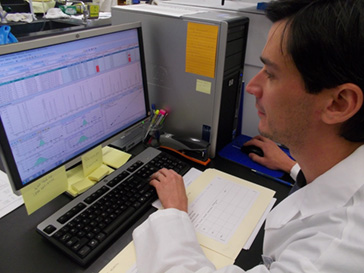
The organic laboratory section uses gas chromatography, gas chromatography- mass spectrometry (GC-MS), gas chromatography-tandem mass spectrometry (GC-MSMS), and liquid chromatography-tandem mass spectrometry (LC-MSMS) for trace level organic analyses. This state of the art instrumentation allows for the determination of a suite of analytes: polynuclear aromatic hydrocarbons (PAHs), brominated flame retardants, insecticides, herbicides, fungicides, rodenticides, piscicides, pharmaceuticals, and algal toxins in water, sediment, soils and/or biota.
The organic laboratory was instrumental in developing parts per trillion level analytical capabilities of pyrethroid insecticides in water and sediment using gas chromatography-tandem mass spectrometry with negative chemical ionization. Pyrethroid insecticides are highly toxic to aquatic life at parts per trillion levels. This methodology allows for the monitoring of these compounds at environmentally relevant concentrations and at toxicity thresholds of sensitive aquatic species.
The organic laboratory has developed, validated, and published methods for the analysis of marine and freshwater harmful algal toxins in water and biological tissues using liquid chromatography-tandem mass spectrometry. The organic laboratory plans to expand the analyte list as standards of new variants of specific algal toxins become available.
The organic laboratory has been contracted by the California Department of Pesticide Regulation (CDPR) to provide method development, sample analysis, and quality assurance for various monitoring projects. For example, an analytical method has been developed and validated for a suite of urban use pesticides using a continuous low level aquatic monitoring (C.L.A.M.) sampling approach. Custom method development for a suite of rice herbicides has also been developed and validated for CDPR. The rice herbicide method has been utilized for both monitoring and quality assurance purposes.
The laboratory provided PAH analysis of tissues in response to the fisheries closure as a result of the May 2015 Refugio Beach oil spill in Santa Barbara. The laboratory also continues to provide tissue and water analyses of PAHs in support of the Natural Resource Damage Assessment (NRDA) for the Refugio spill response.